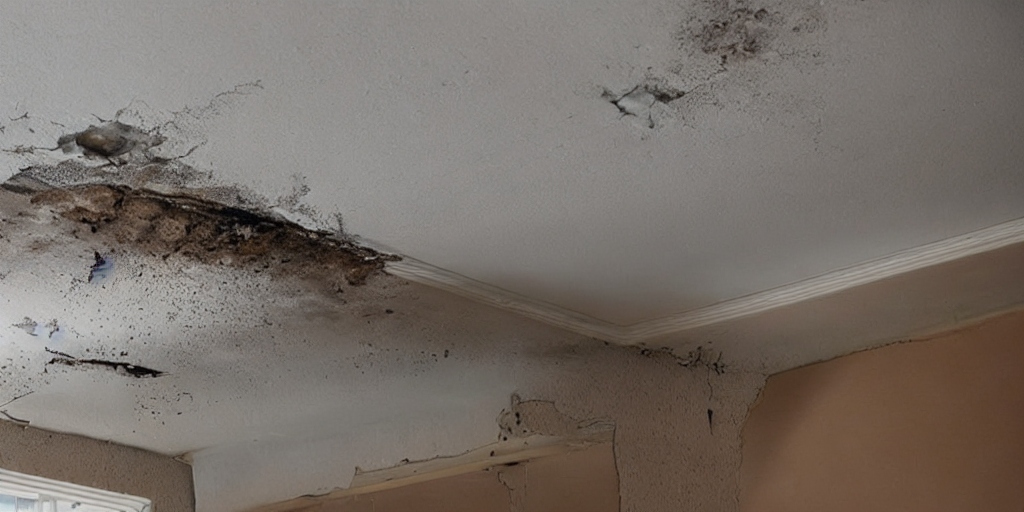Introduction
Water damage to ceilings can be a homeowner’s nightmare, causing not only unsightly aesthetic issues but also potentially leading to structural damage and health hazards. Understanding the common causes, signs, and remedies for ceiling damage from water is crucial for homeowners to effectively address and mitigate the problem. In this comprehensive guide, we delve into the various aspects of ceiling water damage, from its causes to the necessary steps for remediation.
Common Causes of Ceiling Water Damage
Extreme Weather Events
Storms, hurricanes, heavy rains, snow, and ice can damage your roof and ceiling. When severe weather strikes, the integrity of your roof may be compromised, leading to leaks and subsequent water damage to the ceiling below. Regular inspection and maintenance of your roof can help identify potential vulnerabilities before they escalate into significant issues.
Clogged Gutters
Twigs, leaves, and granules can clog your gutters and direct water to your home. When gutters become obstructed, rainwater can overflow and seep into the walls and roof, eventually causing damage to the ceiling. Regular gutter cleaning and maintenance are essential for preventing water intrusion into your home’s interior spaces.
Malfunctioning Appliances
Condensation from your AC unit could damage your ceiling. A clogged drainpipe or a full drain pan may leak into your ceiling. Appliances such as air conditioning units and water heaters can also be sources of water damage if not properly maintained or if they develop leaks. Prompt repair of any malfunctioning appliances is crucial to prevent further damage to your home.
Leaky Plumbing
Faulty pipes above your ceiling can wreak havoc in your home. Whether it’s a burst pipe or a slow leak, plumbing issues can cause significant water damage to ceilings and other areas of your home. Regular inspection of plumbing systems and timely repairs can help prevent water damage before it escalates.
Also Read: Water Damage to Hardwood Floors: A Comprehensive Guide
Signs of Ceiling Water Damage
Discoloration
One of the most common water damage signs is brown patches on the ceiling. As water seeps into the ceiling material, it can cause discoloration, typically appearing as brown or yellow stains. These stains may grow larger over time as the water damage worsens.
Mold Growth
Mold is a clear sign of moisture problems in your home. If you notice green or black patches on your ceiling, it’s likely that mold has begun to grow. Mold not only poses health risks but also indicates ongoing moisture issues that need to be addressed promptly.
Sagging or Bulging
Water may spread from the ceiling into the walls and doors. As water accumulates within the ceiling material, it can cause sagging or bulging, indicating significant water damage. This structural compromise requires immediate attention to prevent further deterioration.
Peeling Paint or Wallpaper
Water damage causes the wallpaper and trims to peel from walls. Another visible sign of ceiling water damage is peeling paint or wallpaper near the affected area. The moisture from the water intrusion can cause adhesives to weaken, leading to detachment of wall coverings.
Impact of Ceiling Water Damage
Structural Damage
Your plaster and drywall form brown patches and dirt lines as the water leaks. Prolonged exposure to water can weaken the structural integrity of ceilings, leading to sagging, crumbling, or even collapse in severe cases. Timely intervention is crucial to prevent further structural damage.
Mold Infestation
Brown and black patches on your ceiling may begin to develop shortly after some water damage. Mold thrives in moist environments, and a water-damaged ceiling provides the perfect breeding ground. Mold not only damages building materials but also poses health risks to occupants, particularly those with respiratory issues.
Fire Hazard
Having water in your electrical wiring increases the risk of a fire hazard. Water intrusion into ceiling spaces can come into contact with electrical wiring, posing a fire risk. It’s essential to have a professional assess and repair any water-damaged electrical components to mitigate this hazard.
Slip and Fall Accidents
A leak from your ceiling could form a puddle on the floor. Water pooling on floors beneath a leaking ceiling can create slip and fall hazards, especially if not promptly addressed. This poses a risk to occupants, particularly children and the elderly.
Rising Utility Bills
Water affects the insulation’s performance, which causes the power bills to rise. Water-saturated insulation loses its effectiveness, leading to increased energy consumption as heating and cooling systems work harder to maintain desired temperatures. Addressing water damage promptly can help restore energy efficiency.

Remediation Steps for Ceiling Water Damage
Stop the Source of Water
Once you’ve identified the source, do what you can to stop the influx of new water. Whether it’s repairing a leaking roof, fixing faulty plumbing, or addressing appliance malfunctions, stopping the source of water intrusion is the first step in remediation.
Dry Out Affected Areas
Time to remove the water that has accumulated as well as any materials that have been damaged. Using industrial drying equipment, such as fans and dehumidifiers, is essential to thoroughly dry out affected areas and prevent mold growth. Professional water restoration services can ensure thorough drying and mitigate further damage.
Repair and Replace Damaged Materials
For this final step, you’ll likely need to bring in a qualified company to repair and replace the ceiling. Professional contractors can assess the extent of the damage and perform necessary repairs to restore the ceiling to its pre-damaged condition.
Also Read: Signs of Water Damage on Ceiling: What You Need to Know
Conclusion
Ceiling water damage can have serious implications for homeowners, ranging from aesthetic issues to structural damage and health hazards. By understanding the common causes, signs, and remediation steps for ceiling water damage, homeowners can take proactive measures to protect their homes and mitigate the effects of water intrusion. Prompt action and professional assistance are essential in addressing ceiling water damage effectively and restoring the integrity of the home.
In conclusion, vigilance, maintenance, and timely intervention are key to safeguarding your home against the damaging effects of water intrusion into ceilings.










